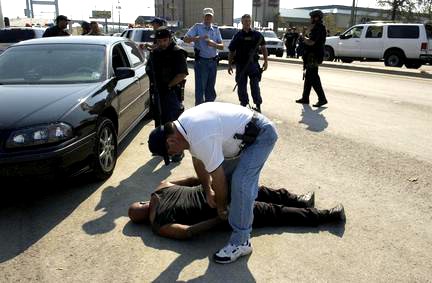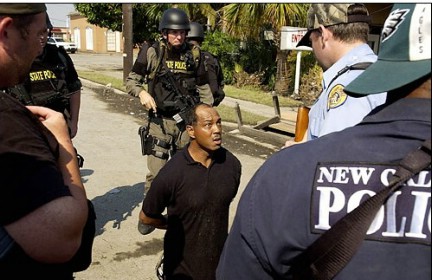|
.........
New Orleans Shooting Cover-Up: The Worst Type of Police Corruption
Lt. Michael Lohman's actions exposed his subordinates to legal jeopardy
~~~~~~~~~~~~~~~~~~~~~~~~~~~~~~~~~~~~~~~~~~~~~~~~~~~~~~~~~~~~~~~~~~~~~~~~~~~~~~~~~~~~~
 |

Danziger Bridge Incident - Cover-up and corruption in New Orleans
----------------------------------------------------------------------------------------
officers provided false info, failed to investigate fully, planted a weapon |
|
New Orleans Shooting Cover-Up: The Worst Type of Police Corruption
Lt. Michael Lohman's actions in the aftermath of Hurricane Katrina exposed his subordinates to legal jeopardy far beyond that which may have been warranted.
OPINION - by Jack Dunphy
EDITOR'S NOTE: “Jack Dunphy” is the pseudonym of an officer with the Los Angeles Police Department. Our non profit at LA Community Policing (LACP) has been a frequent forum for his writing. The opinions expressed are his own and almost certainly do not reflect those of the LAPD management.
March 13, 2010
Pajamas Media
It has been nearly five years since Hurricane Katrina ravaged the city of New Orleans. In that time, neighborhoods have been rebuilt, businesses reopened, and, perhaps most importantly, civic spirit reawakened. And, in what some believe was the very hand of Providence at work, even the once lowly Saints won the Super Bowl just in time for Mardi Gras. |
|
| |
But even as things appear to be looking up for New Orleans, there remains in the Crescent City a stubborn stain, one that won't be as easily painted over or washed away as the high-water marks still visible in some parts of town. Last month, a former New Orleans Police Department lieutenant pleaded guilty in federal court to conspiring to obstruct justice in the aftermath of a September 4, 2005, police shooting in which two people were killed and four wounded.
The former lieutenant, Michael Lohman, admitted that he orchestrated a cover-up after coming to the scene of what has come to be called the Danziger Bridge incident and concluding that the shooting could not be legally justified. According to the Bill of Information filed in the case, Lohman “tacitly encouraged” officers to provide false and misleading information about the shooting to investigators. He also failed to ensure that a thorough investigation was conducted at the scene of the shooting by failing to see that evidence be collected, witnesses be interviewed, and a diagram of the scene be created, all of which are the most rudimentary of steps in any such investigation. Even worse, Lohman encouraged an investigator to plant a “clean” gun, i.e., one whose chain of possession cannot be traced, beneath the Danziger Bridge in a post facto effort to provide justification for the shooting.
This is the very worst type of police corruption. Lohman was a lieutenant, and as the senior officer at the shooting scene he had a duty, both moral and legal, to provide leadership to subordinates who, in the aftermath of Katrina, were working under conditions no police officer who didn't experience them can imagine. He failed miserably, and in that failure he exposed those subordinates to legal jeopardy far beyond that which may have been warranted had they all simply told the truth about what had occurred. |
|
|

Sept. 4, 2005, shootings on the Danziger Bridge that killed two men and injured four |
|
Granted, if the conspiracy existed as described in the Bill of Information, all the participants should be held accountable. But there are questions that demand answers: When the first officer opened fire at the Danziger Bridge, what threat, if any, did he perceive that prompted him to shoot? And once the first shots were fired, did the others shoot at perceived threats, or was it a case of “contagious gunfire”? Finally, after the shooting had stopped, at what point and at whose direction was it decided to fabricate the account of the incident?
Had Lohman done his duty and seen to it that a genuine investigation be completed, some or all of the involved officers may nonetheless have found themselves in legal jeopardy, but they would not today be burdened with the presumption that inevitably accompanies a cover-up. By coming to the Danziger Bridge and participating in the whitewash of a “bad” shooting, Lohman denied his officers the opportunity to defend their actions as reasonable under the circumstances. Any such claims made in the future will ring hollow in the light of what Lohman allowed to occur.
There have been many police shootings in which officers have shot people they reasonably though erroneously thought presented a threat. Perhaps the most well known of these is the case of Amadou Diallo, who in 1999 was shot and killed by four NYPD plainclothes officers. |
| |
The officers were charged with second-degree murder and other charges, but were acquitted after testifying that they believed Diallo, who resembled a man wanted for rape, was pulling a gun when he in fact was pulling out his wallet. Yes, the officers went through the ordeal of a trial, but by being forthright during the investigation and in their testimony at trial, they persuaded the jury that their actions in shooting Diallo were, though tragically mistaken, reasonable. The jury almost certainly would have reached a different conclusion had the officers planted a gun on Diallo or otherwise attempted to fabricate some justification for the shooting.
Here in Los Angeles, a central event in what came to be known as the Rampart scandal was a shooting in which a gang member named Javier Ovando was shot and paralyzed by Officers Rafael Perez and Nino Durden, two of the scandal's central figures. After shooting Ovando, Perez and Durden planted a gun on him, then fabricated an account of the shooting which led to Ovando's imprisonment. The Ovando incident led to changes in the way the LAPD investigates officer-involved shootings, and protocols now in place make it unlikely that officers can collude to cover up an unjustified shooting.
The New Orleans Police Department had similar protocols for officer-involved shootings but, like much of the department's infrastructure, those protocols were washed away when Katrina brought the levees down. The personnel that ordinarily would have responded to a police shooting simply weren't available, which obligated Michael Lohman all the more to see to it that those rudimentary investigative steps mentioned above were taken.
And the Danziger Bridge shooting wasn't the only one in which the official police accounts have been questioned. Reporters from the New Orleans Times Picayune, PBS's Frontline, and ProPublica have worked together to examine these incidents, the full truth of which in some cases may never be known.
Which makes the Danziger Bridge conspiracy all the more pernicious. By fabricating evidence to cover up a wrongful shooting, the officers at the Danziger Bridge cast a long shadow of doubt on their entire department, the vast majority of whose members performed selflessly and valorously as Katrina struck and in the chaotic days that followed. If officers were anxious and too quick to shoot in some instances, it was not entirely without justification. New Orleans long ago earned the reputation as the country's murder capital, a dubious title it retains to this day. (See here, for example, at how horrifyingly common murders are in some parts of the city.) And recall too that Officer Kevin Thomas was shot in the head by one of four suspected thieves he stopped in New Orleans's Algiers neighborhood the day after Katrina struck.
And if we acknowledge that the officers lied about the Danziger Bridge shooting, we must also allow that those who accuse the police of unjustified shootings may also have their motivation to lie. One of the shootings called into question by the Times-Picayune was that of Keenon McCann, who, police alleged, was shot while armed with a handgun while on an overpass near the Superdome on September 1, 2005. No gun was recovered, and police speculated that McCann threw it either into the floodwaters below or onto an adjacent overpass where it was picked up and carried away.
The McCann shooting put me in mind of a 1991 incident here in South Los Angeles. On the day after Thanksgiving, LAPD officers responded to reports of shots fired in the Imperial Courts housing project, known then as now for its gang activity and violent crime. Officers traded gunfire with some gang members, one of whom was Henry Peco, who was armed with an AK-47 rifle. Peco was killed in the gunfight, but in the confusion that followed the shooting someone picked up and escaped with the rifle Peco had been firing. Peco's family claimed he had been shot while unarmed, and the incident led to days of marches and protests, some of which were joined by Jesse Jackson and Congresswoman Maxine Waters. The protest movement was finally deflated when two men pleaded guilty to attempted murder and to taking and hiding Peco's rifle.
As happened in the Peco shooting, it is entirely plausible that Keenon McCann was armed with a gun, and that the gun disappeared before the police could secure it. Sadly, the revelations about the Danziger Bridge shooting make it that much easier to believe McCann's claim that he was unarmed. McCann filed a lawsuit against the New Orleans Police Department, but in a strange twist of fate he never saw it go to trial. He was murdered in August 2008, a crime that remains unsolved.
New Orleans has made great strides in the years since Katrina devastated the city, but if it is to surrender the title of America's murder capital it will need an effective police department. And if the police are to be effective they must win and maintain the trust of the citizens they serve. Michael Lohman and his fellow conspirators have done incalculable damage to that trust and left to others the task of rebuilding it, a feat in many ways far more difficult than rebuilding a city. But if the Saints can win the Super Bowl, perhaps anything is possible.
“Jack Dunphy” is the pseudonym of an officer with the Los Angeles Police Department. The opinions expressed are his own and almost certainly do not reflect those of the LAPD management. |
|
|
|
 |

|